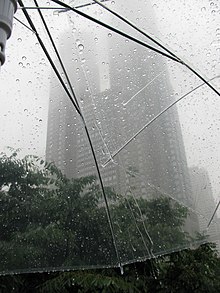Monsoon season in East Asia
 Plum rain falling on two clear umbrellas, looking up toward the Tokyo Metropolitan Government Building, in June 2009.
Plum rain falling on two clear umbrellas, looking up toward the Tokyo Metropolitan Government Building, in June 2009.
The East Asian rainy season (Chinese and Japanese: 梅雨; pinyin: méiyǔ; rōmaji: tsuyu/baiu; Korean: 장마; romaja: jangma), also called the plum rain, is caused by precipitation along a persistent stationary front known as the Meiyu front for nearly two months during the late spring and early summer in East Asia between China, Taiwan, Korea and Japan. The wet season ends during the summer when the subtropical ridge becomes strong enough to push this front north of the region. These weather systems can produce heavy rainfall and flooding.
